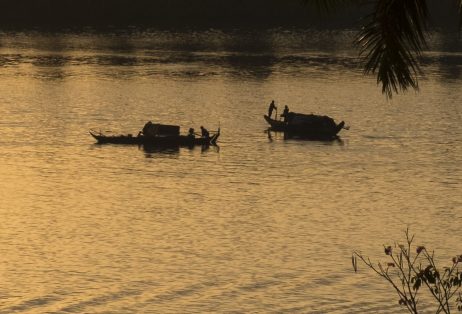By Luke Hunt
 At dawn on the Mekong River, fishermen start plying the waters, often heading out for two or three hours, two or three times a day. But the lower Mekong Basin is suffering its second year of drought.Credit: Luke Hunt
At dawn on the Mekong River, fishermen start plying the waters, often heading out for two or three hours, two or three times a day. But the lower Mekong Basin is suffering its second year of drought.Credit: Luke Hunt
Fisherman cast their traditional nets into the Mekong River in southern Laos.Credit: Luke Hunt
In full flood the Mekong Delta is bigger than the size of Belgium. But upstream dams in China and Laos, coupled with climate change, have exacerbated the drought.Credit: Luke Hunt
A fish catch is laid out to dry in the sun and then stored. Some 70 million people live hand to mouth and rely on the Mekong for their daily protein.Credit: Luke Hunt
A fisherman prepares his nets by the Mekong River in Kien Svay, Cambodia near the Vietnamese border. At this time of year, water levels normally reach the edge of his balcony.Credit: Luke Hunt
Village fishermen repair their broken nets.Credit: Luke Hunt
Twenty years ago fisherman would catch 20 kilograms of fish a day. That catch is now down to two or kilograms: “Barely enough to feed the village cat.”Credit: Luke Hunt
Children fish by an exposed drain where the Mekong River meets the Tonle Sap in Phnom Penh.Credit: Luke Hunt
Water levels have dropped sharply. The Mekong River Commission says rainfall for May to July was 70 percent lower than a year ago.Credit: Luke Hunt
Women gut fish to feed the family on the banks of the Mekong River. Muslim Cham are prominent fishing folk across the delta.Credit: Luke Hunt
An expatriate prepares to board a boat on the Mekong through the mud.Credit: Luke Hunt
Puddles along the Mekong and its tributaries near Kampong Svay, central Cambodia.Credit: Luke Hunt
At Kien Svay water levels are about 4 meters, well below the 8.5 meter mark that is normal for this time of the year.Credit: Luke Hunt
Boats docked where the Mekong River meets the Tonle Sap in Phnom Penh are telling in regards to the lack of water. This year’s water festival, normally held in early November, has been cancelled.Credit: Luke Hunt
In Phnom Penh the rains finally arrived around mid-August, but whether there will be enough to end the drought is doubtful amid allegations of water hoarding by the Chinese.Credit: Luke Hunt
Drought, climate change, and the construction of dams – on a scale that beggars belief – are threatening a river system that traverses five countries and feeds 70 million people who live hand to mouth.
For a second year in a row the Mekong River is at a record low, reduced to a trickle when it should be heading into a full flood. Water levels are down by two-thirds and rainfall for the three months of the current wet season is also down by about 70 percent.
The annual water festival has been cancelled.
Where the river empties into the South China Sea, at least two of 12 exits have closed. Salinity is creeping further inland, threatening 850 already endangered fish species. Fishermen complain their daily catch has been reduced to a kilogram or two, enough for just the village cat.
The Mekong River Commission (MRC) forecasted that the “extreme drought” is now expanding across northern Cambodia, southern Laos, and into central Vietnam.
It described the plight of the Tonle Sap as “very critical” with water depths across the Lower Mekong Basin below the minimum levels recorded in 1960 and 2019.
“The current low flows could have severe impacts on Cambodia due to a loss of fisheries and irrigation potential,” said An Pich Hatda, chief executive of the MRC Secretariat in Vientiane.
“It is time to walk the talk and to act in the common interest of the entire Mekong River Basin and the affected communities.”
It’s an unprecedented man-made problem, which the military-backed governments and one-party states of mainland Southeast Asia are choosing to ignore as Beijing and financial institutions pour billions of dollars into hydroelectricity, profiting the powerful few.
According to the Stimson Center, a think tank in the United States, a cascade of more than 400 dams in China and Laos have been been built, are under construction, or are on the drawing board.
There is no evidence to suggest “fish ladders” – much touted as the answer for migrating fish deprived of their upstream breeding grounds – have worked. A report by research company Eyes on Earth Inc. has accused China of hoarding water behind its dams, a charge denied by Beijing.
A severe lack of sediment needed to constantly replenish river banks has resulted in large parts of the river system turning from brown to blue. That may be prettier to look at, but soil erosion is now looming as a threat to the thatched homes, glitzy skyscrapers, factories, and highways lining the waterfronts.
Meanwhile, climate change has exacerbated the impact of the Indian Ocean Dipole, similar to the El Nino weather pattern in the Pacific Ocean and sometimes known as the Indian Nino.
Unusually cool sea surface temperatures across the eastern half of the Indian Ocean and warmer water in the west cause floods in East Africa and drought in Southeast Asia.
It’s a phenomenon that has been peaking at record extremes. The Indian Ocean Dipole historically occurs once every 17.3 years, but scientists are forecasting its frequency will increase to once every 6.3 years over this century due to carbon emissions and excess energy in the atmosphere.
Luke Hunt can be followed on Twitter @lukeanthonyhunt
No comments:
Post a Comment